Most companies today have multiple cloud instances with multiple cloud service providers (CSPs) as well as an on-premises environment. It’s complex, but that doesn’t make it inherently wrong—there are usually good business reasons behind the decisions. It does, however, create management challenges. Our recent State of Multi-Cloud Management survey looked into the number of different instances and CSPs organizations are juggling and what impact it’s having on IT teams and their ability to meet business needs and achieve desired outcomes.
It’s a hybrid multi-cloud world
Very few organizations aren’t using public and private clouds at all (0.3% and 2% respectively). The vast majority have a solid mix of public and private clouds.
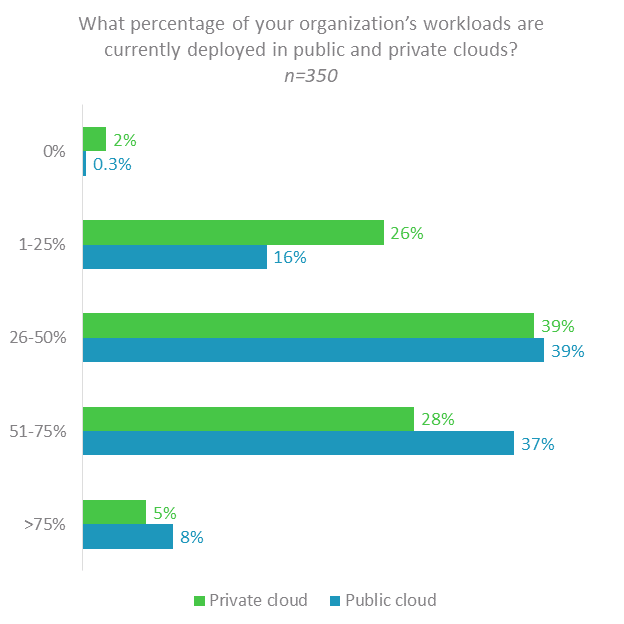
Furthermore, the public cloud isn’t a single environment—83% of respondents use more than one CSP, and 44% use more than three CSPs.
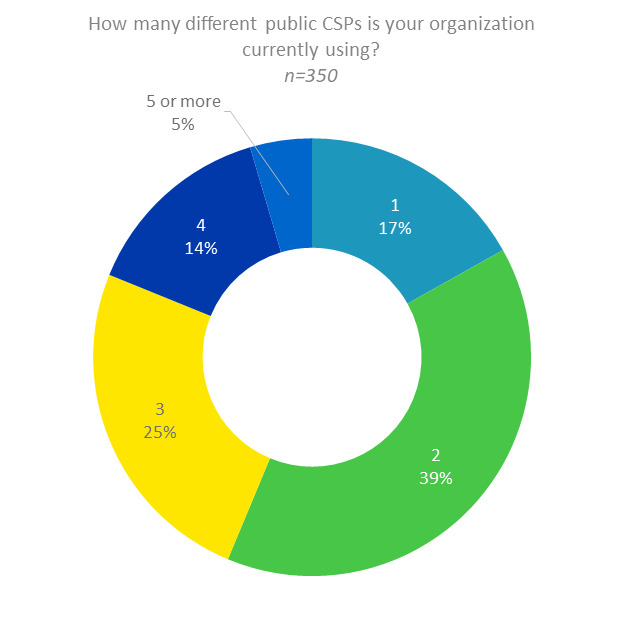
Complexity doesn’t come just from managing multiple CSPs; 77% of organizations manage more than four or more instances, and 22% manage 11 or more.
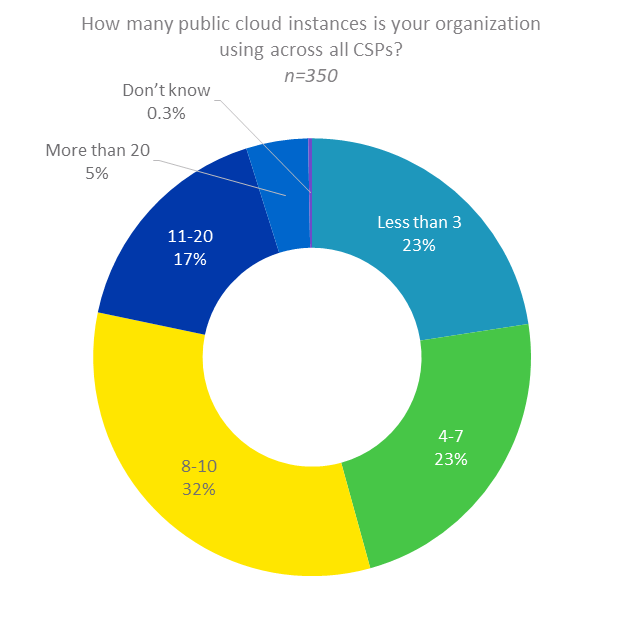
It’s not surprising that the more CSPs a company uses, the more instances it manages. But even 45% of those using just one CSP have four or more instances.
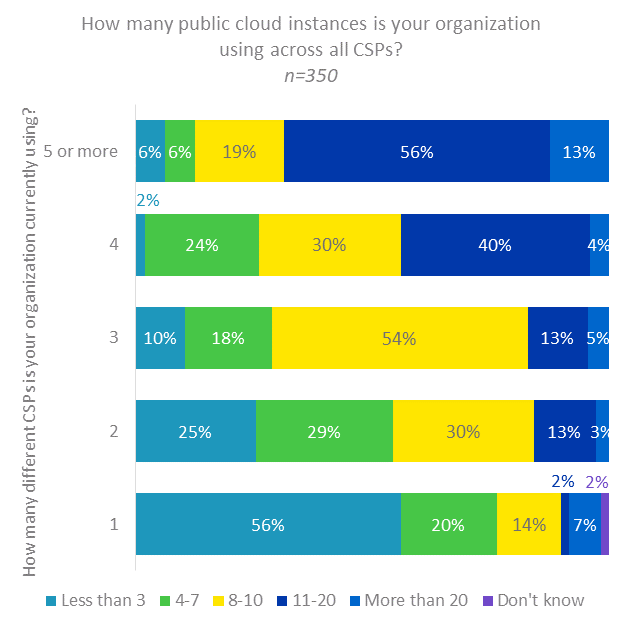
The challenges of more
Intuitively, more CSPs and more instances create management challenges. We asked respondents what their number-one challenge is related to managing their hybrid/multi-cloud infrastructure among the following:
- Keeping rising costs under control
- Finding and eliminating wasted spend
- Staying optimized/rightsized on an ongoing basis
- Getting a global view of utilization and spend across the entire infrastructure (on premises, private cloud, all public clouds)
- Mapping utilization and spend back to business entities (LoBs, projects, locations, etc.)
- Making appropriate workload placement decisions
- Ensuring performance and availability
- Understanding the impact of changes on cost and performance
- Lack of skills/expertise
- Understanding/minimizing the carbon footprint of IT operations
The top challenge for respondents using five or more CSPs, cited by 31% of that cohort, was keeping rising costs under control, compared to 17–26% of respondents with fewer CSPs to manage. The number-two challenge, at 25%, was finding and eliminating wasted spend, which was a far bigger problem than for organizations managing fewer CSPs—just 8–14%. This makes sense—with more CSPs in play, there are more places for unnecessary costs to “hide.”
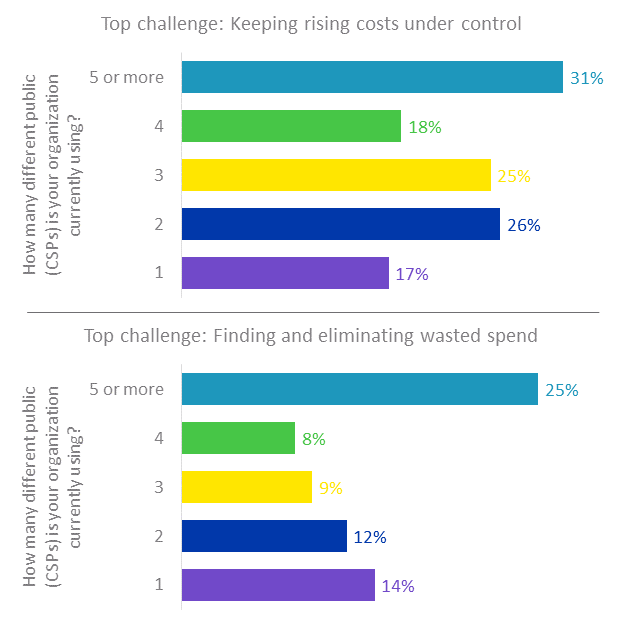
There’s less of a stark difference when we look at the top challenges based on the total number of instances being managed, but there is still a discernable trend. One-fifth (21%) of businesses with more than 10 instances reported that getting a global view of utilization ad spend across the entire hybrid/multi-cloud infrastructure is their top challenge, roughly the same number as the rest of the respondent groups (18–22%). There’s more of a difference in the number-two trend: staying optimized/rightsized on an ongoing basis. This is a problem for 20% of organizations with more than 10 instances but for only 13% of those using less than three. Rightsizing is challenging enough, but with many instances—each likely running different kinds of workloads with their own utilization and risk profiles and performance requirements—it can be impossible to keep up.
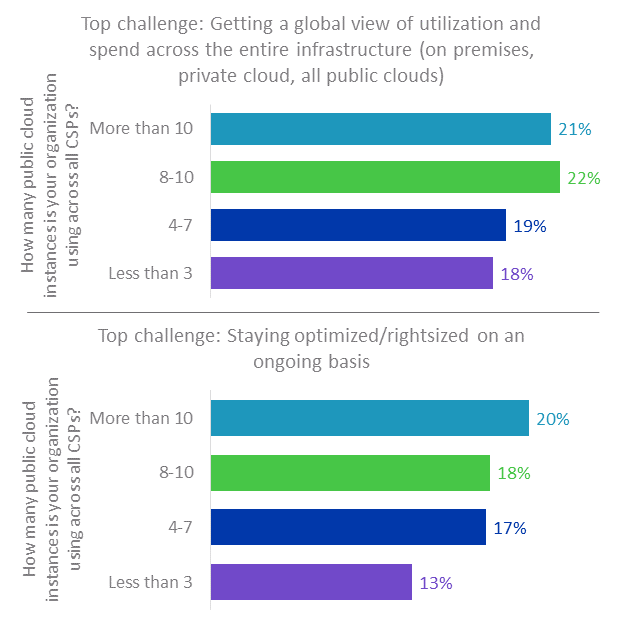
You don’t need to simplify your environment—just its management
Less isn’t always more, and the goal here isn’t necessarily to reduce the number of CSPs and instances you’re using. CSPs are not one-size-fits-all, so going multi-cloud to take advantage of specific capabilities is often the appropriate strategy. And your business needs the flexibility to add instances to support evolving requirements. But you can streamline the management of it all. Virtana Cloud Cost Management, part of the Virtana Platform, helps you do just that. With Virtana Cloud Cost Management, you can:
- Find and eliminate wasted spend, such as unused compute instances, storage blocks no longer attached to a compute instance or attached to a stopped instance, unattached load balancers, and idle elastic IP addresses.
- Automatically optimize instances with rightsizing recommendations, and tune sizing based on your organization’s risk tolerance with what-if analysis that includes CPU, memory, I/O, and ingress and egress charges.
- Gain deep insight into your cloud bills across cloud providers, easily slicing and dicing the data to match specific business needs.
All of this—and more—allows you to avoid end-of-the-month billing surprises and stay on budget, even as conditions and options change. Try Virtana Cloud Cost Management for yourself
Get the survey report: The State of Multi-Cloud Management
Optimize storage across your hybrid infrastructure: Try Virtana Cloud Cost Management for free

David McNerney
Director of Product Management for Container Observability




